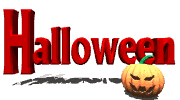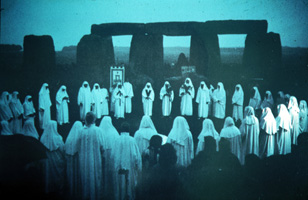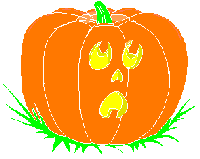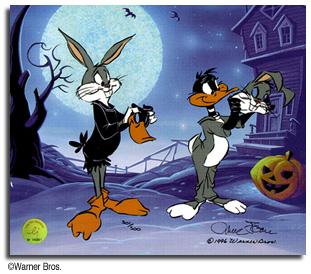
This page is intended to give the two major views of the origin
of Halloween, by identifying facts from Historical recorded accounts, and theories that Christians, and non-Christians
have. What you choose to believe about Halloween is left to you.
"All Hallow's Eve"
Historical records of the "Druids of Gaul" who were civil and religious authorities, judges and priests over the Celts (500 AD.).
v.4, p.185, 2a, Compton's Encyclopedia, E.E.Compton Co., Chicago, IL, '84
People innocently suppose that the Celts and their priests, the Druids,
celebrated a festival that marked the eve of the Celtic New year "Vigil of Samhain". Samhain was
the druids god of death, their most powerful god. The fall harvest was complete and winter loomed ahead. The Celts believed
the power of the sun was fading and the next several months,would be dark.
They believed that during Samhain that on the evening of October 31(some think September 22 autumnal solar equinox) that evil spirits and the souls
of the dead passed
through the barrier and entered the world of the living. Departed family members would go back to their earthly homes. These spirits and dead souls could torment the living.
Crops might be destroyed, babies stolen, farm animals killed. Many human sacrifices were also offered to Samhain on this
night to get good crops the next year.
The Devil's power would be called on to foretell (devine)
the future to know how the crops would do. Tom McKenney "Live Free" Words for living Min, Inc. MARION, KY 42064
v.15, p.433, 2a, Encyclopedia Britannica, Chicago, IL, 1992
 |
We know little about the Druids because they never wrote anything
down.
Rhys, Prof., Celtic Heathendom, Modern America Corp., Chicago, 1936 |
"Our information about the druids is borrowed from notices from Greek and Roman writers,
compared with the remains of Welsh and Gaelic poetry. The Druids doctrine, history,
poetry, and teaching was oral, preserved solely by tradition.".
p358-361, Bulfinch, Thomas, Bulfinch's Mythology, Anenel Books, NY, 1978
By the time the Church began an October 31 celebration of Halloween the Druids had been extinct for hundreds of years.
v.6, p.281, 2b, Academic American Encyclopedia, Danbury, CN, 1989
v.1, p.275, 2a, Encyclopedia Britannica, Chicago, IL, 1992
"All Saints Day," or Christian Memorial Day
For 300 years after Christ, the Early Church was horribly persecuted. Christians were captured and tortured for days before being murdered, all
because they refused to recant the name of Jesus! Rome killed over seven million believers, men, women and children. In A.D. 373, the killing was over, and Christians began remembering
their heritage with a Memorial Day. Originally held on May 13, it was called "Martyrs Day" until 609 when it was changed
to "All Saints Day," and was also known as the "Hallowed (holy or sanctified) Day". On this day they remembered those who had given their lives for the Faith during the Great Christian
Holocaust, by Rome. It was observed by the Eastern Syrians on May 13 and by the West Syrians and Byzantines on the Sunday following Pentecost. Pope Boniface IV received from the emperor
Phocas (reigned 602-610) the Pantheon at Rome, which he dedicated on May 13 to St. Mary and All Martyrs.
Many Christians changed their celebrations to November 1 when an old building in Rome, formerly used to torture Christians, was ironically dedicated
to their memory on Nov 1, 734. The Church made the change official worldwide, in 835.
v.16, p.308, 1a Encyclopedia Britannica, Chicago, IL, 1992
In ancient cultures, each day began at dusk. Many, including the Jews, still practice this. What we call Friday night, they would call Saturday
night, because the evening always came before the day, just as God created them.
Genesis 1:5, Holy Bible
In the same way, celebration of the "Hallowed Day" began on the evening before the day, the "Hallowed Even." This was shortened over time to the contraction
"Halloween," and has remained that way until today.
v.1,p.370, 1a, World Book Encyclopedia, Chicago, IL, 1992
Conclusion
What do you choose to believe about Halloween's symbols?
Because of similar names, and adjacent dates, a few people think that Halloween is a Christian holiday. Is it a Memorial Day for faithful believers
following the example of Jesus" (some say that martyred saints stories are inappropriate because they do not appear in Scripture).
Was it right for the Pope to invent "All saints day" to replace the "Festival of Death"?
Or is it a celebration of Evil Spirits used by the Devil that kids re-enact when trick-or-treating?
Then consider the scripture:
"When you enter the land the Lord your God is giving you, do not learn to imitate the detestable ways of the nations there. Let no one be found
among you who...practices divination or sorcery, interprets omens, engages in witchcraft, or casts spells, or who is a medium, or spiritist or who consults the dead?
Deuteronomy 18:9-11 Holy Bible
Haloween Symbols and what people think history says they mean:
Cats
Some suggest that cats are a symbol of Halloween because it was worshiped in Egypt. Others
say that witches sometimes use a cat as a familiar and that they used black (they thought the color of evil) cats. The
only thing that all ancient cultures have in common, when it comes to the cat, is a reverence for it at the harvest
season.
The cat is the only defense-mechanism that an agricultural world had against the mouse, rat, and
snake- all of these pests that could destroy a harvested-crop. So, on the farms the cat is a hero, especially when the harvest
has just been brought in.
Phillips, Phil, Halloween and Satanism, Starburst Publ., Lancaster, PN, 1987
Jack-O-Lantern
 |
The pumpkin is native only to North America, and grows nowhere else in the world. Original
Jack-o-Lanterns were made from turnips, and are recent (1200 A.D.).
Phillips, Phil, Halloween and Satanism, Starburst Publ. Lancaster, PN, '87 |
One belief of the origin of the Jack-o-lantern was at the time of the Druids the evil
spirits slung over their shoulders on a cord, a large, hollowed-out turnip with an oil lamp burning inside. Carved into the side
of the hollow turnip is a hideous face, the likeness of the demon spirit that dwells inside. This spirit was the druid's spirit guide.
When the new world of America was founded the celtic immigrants brought with them their
pagan beliefs. They found pumpkins much easier to hollow out than turnips. Among the english speaking celts the hollowed turnip or pumpkin was known as "Jock or Jack" of the lantern.
This was soon shortened to "Jack of the lantern". Jack referred to their spirit guide who lived inside..
Tom McKenney "Live Free" Words for Living Min. Inc. Box 413 Marion, KY 42064
The most popular origin of the carved pumpkin is a old Irish folktale about a miser named "Stingy Jack," who ignored his wife's attempts to get
him to church, and give to the poor. Instead Jack went to bars, were he met and tricked the Devil into paying for drinks.
Years later, Jack choked to death on a turnip, and was turned away by heaven as a miser.
When Satan saw him coming to hell, he chased him off by throwing a red-hot coal. Jack
caught the coal in the half-eaten turnip he still carried, and was condemned to wander between heaven and hell until Judgment Day because of playing Jokes on the Devil.
Christians would put a carved turnip up to mark the locations of their parties. According
to the legend, if Satan saw such a lantern he would turn and walk the other way rather than risk meeting Stingy Jack -
it became a magic charm to ward off evil.
Phillips, Phil, Halloween and Satanism, Starburst Publ., Lancaster, PN, 1987
v.9, p.25, 1a, World Book Encyclopedia, Chicago, IL, 1992
Trick-Or-Treat
 |
One theory comes from the Druids whose job was to appease the goblins
and prevent harm to the people. It is believed that, like many pagan cultures around the world, the Celts left out
food for the spirits, hoping that a "treat" would prevent an evil "trick."
Centuries later, descendants of the Celts continued to observe the Samhain festival by dressing as evil spirits.
They roamed from house to house demanding food in exchange for the "spirits"
leaving the home unharmed.
Tom McKenney "Live Free" Words for Living Min. Inc. Box 413 Marion,KY 42064 |
On
All Hallows, many churches staged plays called pageants for the benefit of their members. Each pageant participant dressed
up as the patron saint of his special guardian. Everyone, even the audience, came dressed as their favorite martyred
saint - because when Jesus rose from the grave, He too wore the scars of His beatings.
Those who chose to dress as Paul, came beheaded. Those who chose Matthew, came with
a spear thrust through them, James' head was crushed. Those who did not play the part of a 'holy one' played the part
of devils. These were the defeated enemies, booed and hissed, while the victorious heroes were cheered. The procession then
marched from the church out into the churchyard where the play might continue until late in the evening.
After the skits and church services, costumed Christians would go into the streets to
wander from door to door begging for food -- because it was the harvest season, and in the Bible provision was always made for the poor at harvest (Lev 19:9-10).
Many young men took it upon themselves to play pranks on the stingy who did not give enough
to the poor-Treats or a Trick! Originally this was a welfare system practiced by the Early Church, each harvest.
Phillips, P., Halloween and Satanism, Starburst Publ., Penn, 1987 |


